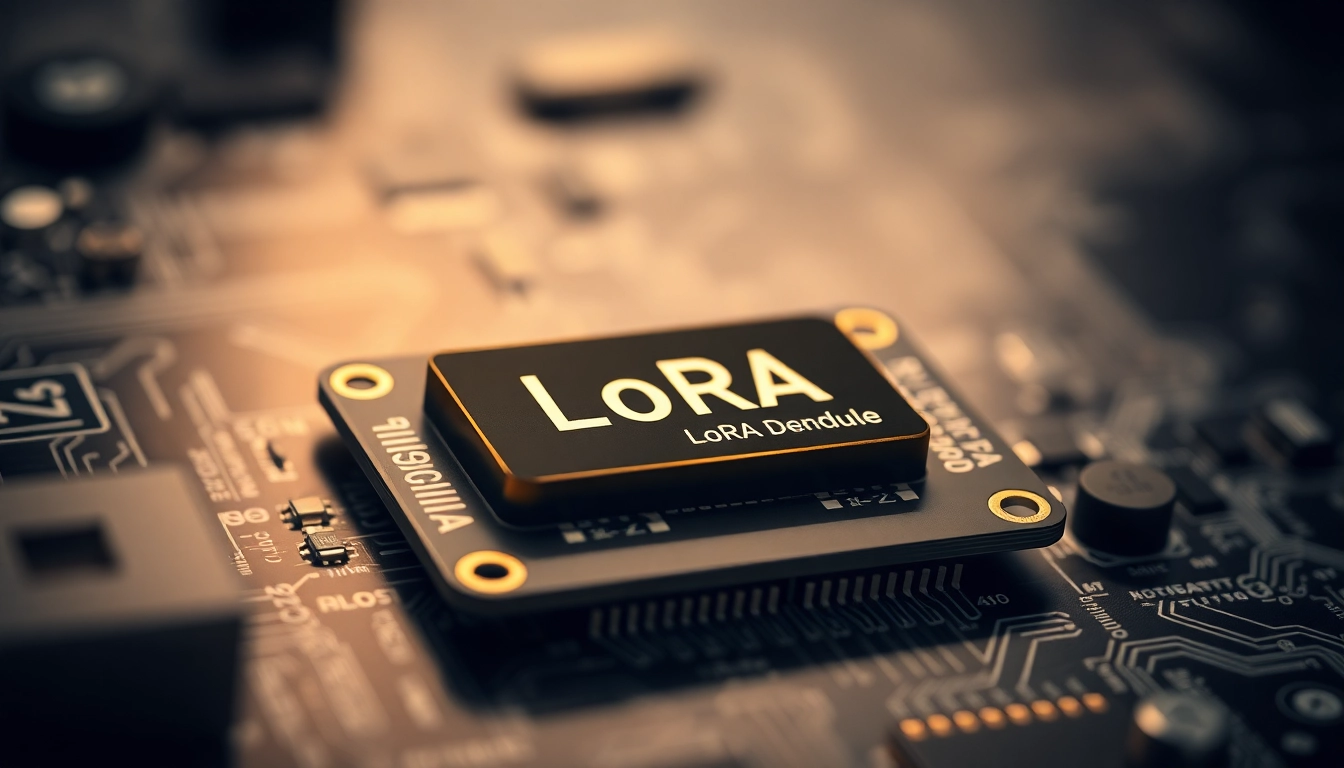
Discover the Versatility of the LoRa Module for IoT Solutions
Introduction to LoRa Module Technology
In today’s rapidly evolving technological landscape, the demand for reliable communication methods in the Internet of Things (IoT) space is greater than ever. Among various communication technologies, the LoRa module stands out for its unique benefits. This article delves deep into the world of LoRa modules, highlighting their significance, applications, and advantages in modern systems.
What is a LoRa Module?
LoRa, which stands for Long Range, is a wireless communication technology designed specifically for long-range transmissions with low power requirements. A LoRa module is essentially a hardware component that incorporates LoRa technology, enabling devices to communicate over long distances without consuming excessive power. These modules are characterized by their ability to transmit small data packets, making them ideal for applications that require intermittent communication rather than continuous data flow.
LoRa modules employ a spread-spectrum modulation technique, allowing them to achieve great distances—often exceeding 10 kilometers in open areas. This technology is particularly advantageous in rural or remote areas where traditional cellular networks may not reach effectively.
Key Features and Benefits
The following are some of the most notable features and benefits of utilizing LoRa modules in various applications:
– Long-Range Communication: As the name suggests, LoRa provides expansive coverage, making it suitable for applications reporting data from remote locations.
– Low Power Consumption: One of the standout features of LoRa modules is their ability to operate on minimal power. This characteristic enables devices to have longer battery lives and lowers operational costs.
– Robust Security: LoRa technology incorporates strong encryption protocols, ensuring that data transmitted over the network is secure and protected from unauthorized access.
– Scalability: LoRa networks can seamlessly support thousands of devices based on the architecture of the network, making it adaptable for various scales of deployment.
– Resilience to Interference: LoRa’s chirp spread spectrum modulation provides resilience against interference from other wireless devices, supporting reliable data transfer even in crowded environments.
Applications in Modern IoT Systems
LoRa modules find their applications across various fields, significantly shaping modern IoT systems. Here are some prominent ways they’re utilized:
– Smart Agriculture: Farmers can deploy LoRa sensors to monitor soil moisture, temperature, and other environmental factors, allowing for precision farming that optimizes resources.
– Industrial Automation: In manufacturing environments, LoRa modules enable the remote monitoring and control of machinery and equipment, improving efficiency and minimizing downtime.
– Smart Cities: Urban planners employ LoRa technology to connect streetlights, waste management systems, and public transportation to a centralized system for enhanced services and efficiency.
– Healthcare: Wearable health monitoring devices use LoRa technology to transmit patient data to health care providers seamlessly, improving patient care through timely interventions.
The Advantages of Using LoRa Modules
Exploring the advantages of implementing LoRa modules can provide insights into why they are becoming a staple in IoT solutions.
Long-Range Communication
One of the primary advantages of LoRa modules is their capability for long-distance communication. Unlike traditional short-range communication protocols, LoRa can span several kilometers, facilitating extensive networks without the need for additional infrastructure. This is particularly beneficial for applications such as environmental monitoring in agricultural fields or wildlife conservation efforts where devices need to transmit data from remote locations.
Low Power Consumption
The architecture of LoRa technology is designed for low power usage, making it ideal for battery-operated devices. The ability to maintain communication while consuming minimal energy extends the life of devices, reducing the frequency of maintenance and battery replacements. As a result, operational costs decrease significantly, making LoRa technology not only efficient but also economic.
Cost-Effectiveness for Businesses
Deploying a network of LoRa-based devices can be economically advantageous. The reduced costs associated with longer coverage mean businesses can install fewer gateways than with traditional cellular or Wi-Fi networks. Additionally, the long-lasting battery life of devices translates to lower total ownership costs. This economic efficiency is particularly appealing to startups and small businesses looking to leverage IoT solutions without incurring heavy initial investments.
Integrating LoRa Modules into Your Projects
Successfully integrating LoRa modules into projects requires careful planning and considerations. Below are steps that can guide this process.
Assessing Compatibility with Existing Systems
Before beginning integration, it is crucial to assess how LoRa modules will interact with existing systems. This involves understanding the hardware and software requirements necessary for a successful integration, as well as ensuring that the data formats and communication protocols align with those of the existing infrastructure. Many LoRa modules come with detailed documentation, which can greatly aid in this process.
Best Practices for Implementation
To maximize the efficacy of LoRa modules in your project, consider the following best practices:
– Conduct a Site Survey: Evaluate the deployment area for potential physical obstructions affecting signal strength and range.
– Use Repeater Modules: In cases where coverage is lacking, deploying repeaters can help extend the range of your LoRa network.
– Prioritize Device Placement: Strategically position devices at optimal locations to ensure maximal coverage and data transmission efficiency.
– Regular Testing: Test the network integrity and device functionality regularly to promptly identify and address issues.
Troubleshooting Common Issues
Like any technical implementation, challenges may arise during the integration of LoRa modules. Here are common issues and suggestions for troubleshooting:
– Weak Signal Strength: If devices are not communicating effectively, assess physical obstructions and consider relocating devices or adding repeaters.
– Data Loss: Ensure devices are within the communication range and functioning properly. Implementing redundancy in critical applications can also mitigate data loss.
– Infrequent Updates: Regularly review the frequency of data transmission settings. Adjust parameters if devices do not meet expected reporting intervals.
Case Studies: Successful Applications of LoRa Technology
To understand the practical implications of LoRa technology, let’s explore several successful case studies where LoRa modules have made a significant impact.
Industrial Automation Solutions
In an industrial setting, a manufacturing plant adopted LoRa technology to monitor equipment and environmental conditions. Utilizing sensors connected through LoRa modules, the facility was able to track machinery performance and identify maintenance needs proactively. This enabled the organization to reduce downtime by 30% and improve overall operational efficiency.
Remote Monitoring in Agriculture
A successful case in agriculture involved a vineyard that deployed LoRa modules to track soil conditions and weather data. The vineyard used data collected from the modules to optimize irrigation practices, resulting in a 20% reduction in water usage and improved grape quality, illustrating how LoRa technology can contribute to sustainable farming practices.
Smart City Developments
In a bustling metropolitan area, local authorities implemented a LoRa-based smart lighting system. By connecting streetlights through LoRa modules, the city successfully achieved real-time monitoring and control of street lighting, leading to energy savings of 35% while improving public safety by ensuring adequate lighting in critical areas.
Stay Updated: Sign Up for Our Newsletter
Education is a continuous journey, especially in the fast-paced world of technology. Keeping abreast of the latest developments can offer significant advantages.
Benefits of Subscription
By subscribing to our newsletter, you gain exclusive insights into industry trends, new products, and advancements in LoRa technology. Regular updates can help you stay ahead in the competitive IoT market and inform your decision-making processes.
What to Expect in Our Updates
Our newsletter provides curated content, including articles, case studies, tutorials, and special promotions that can greatly benefit both newcomers and veterans in the field. Expect guidance on best practices and emerging opportunities related to LoRa modules and related technologies.
How to Get Started
Subscribing is straightforward. Simply visit our website, locate the newsletter sign-up section, and provide your details. Embrace the opportunity to enhance your knowledge and be part of the growing community around LoRa technology.
